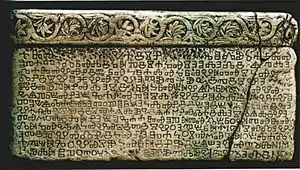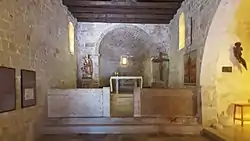Baška tablet
Baška tablet (Croatian: Bašćanska ploča, pronounced [bâʃt͡ɕanskaː plɔ̂t͡ʃa]) is one of the first monuments containing an inscription in the Croatian recension of the Church Slavonic language, dating from c. 1100 AD.
| Baška tablet | |
|---|---|
| Bašćanska ploča | |
 | |
| Material | Limestone |
| Long | 199 cm (78 in) |
| Height | 99.5 cm (39.2 in) |
| Weight | c. 800 kg (1,800 lb) |
| Created | c. 1100[1] |
| Discovered | 1851 Baška, on the island of Krk |
| Present location | Croatian Academy of Sciences and Arts, Zagreb |
History

The tablet was discovered in 1851 during paving of the Church of St. Lucy, Jurandvor near the village of Baška on the island of Krk.
Since 1934 the original has been kept in the Croatian Academy of Sciences and Arts, Zagreb.[1] Croatian archaeologist Branko Fučić contributed to the interpretation of Baška tablet as a left altar partition. His reconstruction of the text of the Baška tablet is the most widely accepted version today.[2]
Description
The Baška tablet is made of white limestone. It is 199 cm wide, 99.5 cm high, and 7.5–9 cm thick. It weighs approximately 800 kilograms.[1][3] The tablet was believed to be installed as a partition between the altar and the rest of the church. A replica is in place in the church.
The inscribed stone slab records King Zvonimir's donation of a piece of land to a Benedictine abbey in the time of abbot Držiha. The second half of the inscription tells how Abbot Dobrovit built the church along with nine monks.[1] The inscription is written in the Glagolitic script, exhibiting features of Church Slavonic of Croatian recension, such as writing (j)u for (j)ǫ, e for ę, i for y, and using one jer only (ъ). It provides the only example of transition from Glagolitic of the rounded Bulgarian type to the angular Croatian alphabet.
Contents

The scholars who took part in deciphering of the Glagolitic text dealt with palaeographic challenges, as well as the problem of the damaged, worn-out surface of the slab. Through successive efforts, the contents were mostly interpreted before World War I, but remained a topic of study throughout the 20th century.[4][5]
The original text, with unreadable segments marked gray:
ⰰⰸⱏ–––––ⱌⰰⱄⰻⱀⰰ––ⱅⰰⰳⱁⰴⱆⱈⰰⰰⰸⱏ
ⱁⱂⰰⱅ–ⰴⱃⱏⰶⰻⱈⱝⱂⰻⱄⰰⱈⱏⱄⰵⱁⰾⰵⰴⰻⱑⱓⰶⰵ
ⰴⰰⰸⱏⰲⱏⱀⰻⰿⱃⱏⰽⱃⰰⰾⱏⱈⱃⱏⰲⱝⱅⱏⱄⰽⱏ–––
ⰴⱀⰻⱄⰲⱁⱗⰲⱏⱄⰲⰵⱅⱆⱓⰾⱆⱌⰻⱓⰻⱄⰲⰵ––
ⰿⰻⰶⱆⱂⱝⱀⱏⰴⰵⱄⰻ–ⱃⱝⰽⱃⱏⰱⱝⰲⱑⰿⱃⱝ–––ⱏⰲⱏ––
ⱌⱑⱂⱃⰱⱏⱀⰵⰱⰳⰰ–ⱏⱂⱁⱄⰾ–ⰲⰻⱀⱁⰴⰾⱑ––ⰲⰰⰲⱁ
ⱅⱁⱌⱑⰴⰰⰻⰶⰵⱅⱉⱀⱁⱃⱒⰵⰽⰾⱏⱀⰻⰻⰱⱁⰻⰱ–ⰰⱀⰾⰰⰻⰳⰵ
ⰲⰰⰼⰾⰻⱄⱅ҃ⰻⰻⱄⱅ҃ⰰⱑⰾⱆⱌⰻⱑⰰⱞⱀⱏⰴⰰⰻⰾⰵⱄⰴⱑⰶⰻⰲⰵ
ⱅⱏⱞⱉⰾⰻⰸⱝⱀⰵⰱ҃ⱁⰳⰰⰰⰸⱏⱁⱀⱝⱅⱏⰴⰱⱃⱉⰲⱜⱅⱏⰸⱏ
ⰴⱝⱈⱏⱌⱃ꙯ⱑⰽⱏⰲⱏⱄⰻⱅⰻⱄⰲⱉⰵⱓⰱⱃⱝⰰⱜⱓⱄⱏⰴⰵⰲ
ⰵⱅⰻⱓⰲⱏⰴⱀⰻⰽⱏⱀⰵⰸⰰⰽⱉⱄⱏⱞⱏⱅⱝⱉⰱⰾⰰⰴ
ⰰⱓⱋⱝⰳⱉⰲⱏⱄⱆⰽⱏⱃⱝⰻⱀⱆⰻⰱⱑⱎⰵⰲⱏⱅⱏⰾNⱜⱞ
ⱜⰽⱆⰾⱝⰲⱏⱉтⱉⱒⱍ–––ⰲⰵт꙯ⱆⱓⰾⱆⱌ꙯ⱜⱓⰲⱏⰵⰾⰻNⱉ
The transliterated text, according to Branko Fučić,[6] with restored segments in square brackets, is as follows:
| Original text transliterated to Latin | The same text in modern Croatian | The same text in English |
|---|---|---|
|
Azъ [vъ ime o]tca i s(i)na [i s](ve)tago duha azъ opat[ъ] Držiha pisahъ se o ledi[n]e juže da Zъvъnim[i]rъ kralъ hrъvatъskъ[ï] [vъ] dni svoję vъ svetuju [L]uciju i s[vedo]mi županъ Desi[m]ra Krъ[b]avě Mra[tin]ъ vъ (li)cě Pr(i)bъnebga [s]ъ posl[ъ] Vin[od](o)lě [Ěk](o)vъ v(ъ) Otocě da iže to poreče klъni i bo(g) i bï(=12) ap(osto)la i g(=4) eva(n)j(e)listi i s(ve)taě Luciě am(e)nъ da iže sdě živetъ moli za ne boga azъ opatъ D(o)brovitъ zъdah crěkъvъ siju i svoeju bratiju sъ devetiju vъ dni kъneza kosъmъta obladajućago vъsu Kъrainu i běše vъ tъ dni Mikula vъ Otočъci [sъ S]vetuju Luciju vъ edino |
Ja, u ime Oca i Sina i Svetoga Duha. Ja opat Držiha pisah ovo o ledini koju dade Zvonimir, kralj hrvatski u dane svoje svetoj Luciji. Svjedoče mi župan Desimir u Krbavi, Martin u Lici, Piribineg u Vinodolu i Jakov na Otoku. Da tko poreče, nega ga prokune i Bog i 12 apostola i 4 evanđelista i sveta Lucija. Amen. Neka onaj tko ovdje živi, moli za njih Boga. Ja opat Dobrovit zidah crkvu ovu sa svoje devetero braće u dane kneza Kosmata koji je vladao cijelom Krajinom. I bijaše u te dane [župa sv.] Mikula u Otočcu sa [župom] svetom Lucijom zajedno. |
In the name of the Father and the Son and the Holy Spirit, I, abbot Držiha, wrote this concerning the land which Zvonimir, the Croatian king, gave in his days to St. Lucia. And the witnesses [were] župan Desimir in Krbava, Martin in Lika, Piribineg in Vinodol and Yakov in Otok. Whoever denies this, let him be cursed by God and the twelve apostles and the four evangelists and Saint Lucia. Amen. May he who lives here pray for them to God. I, abbot Dobrovit, built this church with nine of my brethren in the days of count Cosmas who ruled over the entire province. And in those days [the parish of St.] Nicholas in Otočac was joined with [the parish of] St. Lucia. |
Dating

The tablet's content suggests it was inscribed after the death of King Zvonimir in 1089, since abbot Držiha describes Zvonimir's donation as an event that happened further in the past ("in his days"). The Church of St. Lucy, described as having been built during the reign of prince Cosmas, indicates an era before the Venetian rule on Krk, starting in 1116. This, along with the Romanesque features of the church, dates the tablet to the late 11th or early 12th century.[1][7]
The meaning of the opening lines is contested. While some scholars interpret the introductory characters simply as Azъ ("I"), others believe that letters were also used to encode the year. There is no agreement, however, on the interpretation: 1100, 1077, 1079, 1105 and 1120 have been proposed.[4][8][9]
Significance
The name of Croatia and King Zvonimir are mentioned on the tablet for the first time in the Croatian language.[10]
Despite the fact of not being the oldest Croatian Glagolitic monument (the Plomin tablet, Valun tablet, Krk inscription, are older and appeared in the 11th century) and in spite of the fact that it was not written in the pure Croatian vernacular - it has nevertheless been referred to by Stjepan Ivšić as "the jewel" of the Croatian language,[10] while Stjepan Damjanović called it "the baptismal certificate of Croatian culture".[11] It features a vaguely damaged ornamental string pattern, the Croatian interlace (Croatian: troplet).
The tablet is depicted on the obverse of the Croatian 100 kuna banknote, issued in 1993 and 2002,[12] and on a postage stamp issued by Croatian Post in 2000.
References
- Brozović, Dalibor. "Iz povijesti hrvatskoga jezika". ihjj.hr (in Croatian). Institute of Croatian Language and Linguistics. Retrieved 27 March 2017.
- "Fučić, Branko", Croatian Encyclopedia (in Croatian), Leksikografski zavod Miroslav Krleža, 1999–2009, retrieved January 2, 2014
- "The Baška Tablet - "The Jewel"". info.hazu.hr. Croatian Academy of Sciences and Arts. 16 March 2011. Archived from the original on 18 October 2014. Retrieved 18 December 2018.
- Fučić 1971, p. 238.
- http://www.croatianhistory.net/etf/baska.html
- http://ihjj.hr/iz-povijesti/bascanska-ploca/2/
- Kosmat
- Galović 2018, pp. 267–268.
- Margetić 2007, pp. 11–13.
- "Bašćanska ploča". Croatian Encyclopedia (in Croatian). Miroslav Krleža Institute of Lexicography. Retrieved 2 January 2019.
- Damjanović, Stjepan (7 March 2019). "Bašćanska ploča – krsni list hrvatske kulture". hkm.hr (in Croatian). Hrvatska katolička mreža. Retrieved 22 January 2020.
- Features of Kuna Banknotes Archived 2009-05-06 at the Wayback Machine: 100 kuna Archived 2011-06-04 at the Wayback Machine (1993 issue) & 100 kuna Archived 2011-06-04 at the Wayback Machine (2002 issue). – Retrieved on 30 March 2009.
Bibliography
- Fučić, Branko (September 1971). "Najstariji hrvatski glagoljski natpisi" (PDF). Slovo (in Croatian). Old Church Slavonic Institute. 21: 227–254. Retrieved 2 January 2019.
- Galović, Tomislav (December 2018). "Milan Moguš i Bašćanska ploča" (PDF). Senjski zbornik (in Croatian). 45 (1): 265–285. Retrieved 29 November 2019.
- Margetić, Lujo (December 2007). "O nekim osnovnim problemima Bašćanske ploče" [About some general problems regarding the Baška tablet] (PDF). Croatica Christiana Periodica (in Croatian). Catholic Faculty of Theology, University of Zagreb. 31 (60): 1–15. Retrieved 2 January 2019.
Further reading
- "900 Years of the Baska Stone Tablet (Souvenir Sheet)". epostshop.hr. Croatian Post. Retrieved 22 January 2020.
- Deželić, Mladen (1943). "Baščanska ploča i njeno konzerviranje" (PDF). Ljetopis Hrvatske akademije znanosti i umjetnosti (in Croatian). Zagreb: Croatian Academy of Sciences and Arts. 54: 152–158. Retrieved 22 January 2020.
External links
| Croatian Wikisource has original text related to this article: |
| Wikimedia Commons has media related to Baška tablet. |
